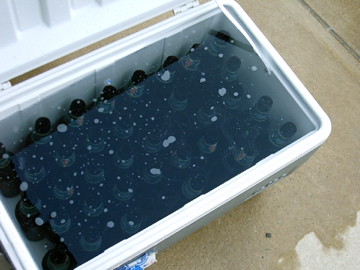Bottling is probably my least favorite part of the whole brewing process. It's tedious, time-intensive, and generally not a lot of fun.
Here's how my bottling process went:
- I started by taking my ~2 cases of bottles that I had (a mix of Saranac, Sierra Nevada, and Carolina Brewing Co bottles), and soaking them overnight in a cooler filled with water (and a small amount of iodophor).

- Then I scraped all the labelling off of the bottles. I do this for two reasons. One, I think a blank bottle looks better than a repurposed Saranac or Sierra Nevada bottle. Two, I sterilize my bottles in the dishwasher, and the labels will come off in there anyway, and I worry about that paper clogging up the dishwasher.
- After scraping, the bottles go in the dishwasher for cycle of "hottest dishwasher setting". This gets them sterilized.

- While that's going on, I get the beer out of the bathtub where it's been patiently waiting, and I take a hydrometer reading to make sure my alcohol content is where I want it.

- Assuming that the beer's ready, I make up a sugar solution of ~1 cup corn sugar plus 2 cups of water (about). This is my priming sugar, and will get mixed into the beer just prior to bottling. Without this, we're drinking flat beer, and frowning while we do it. Once that's done, I transfer the beer from the "fermentation vessel" to my "bottling vessel", mixing in the priming sugar. (Basically, I move it from one bucket to another). I also take my bottle caps and soak them in a solution of "Beer Brite". I don't know what the correct chemical name is, but it's supposed to sterilize them.
- So now, we've got bottles that are ready, caps to put on them, and beer that's been primed. We're ready to go. I like to use the dishwasher to set the bottles on while I'm filling, because it makes less mess. You're inevitably going to get beer spillage, and it's much easier to just close the dishwasher and let the runoff go in there, rather than having to mop the floor.

- I process the bottles in batches while I bottle, filling and capping 12-18 bottles at a time (since I am trying to be somewhat paranoid about cleanliness). Unfortunately, I didn't get a picture of the actual capping (you're not missing much, though). But, I did get a pic of filling:

If you squint, you can see that my left hand is holding the filler. - Finally, after 50 bottles, you end up with this:

- The last step of bottling (other than cleaning up) is just waiting. Once the beer's in the bottle, it has to wait 7-10 days more, so that the priming sugar can generate CO2, and that gas can infiltrate the liquid and carbonate it. However, once it's going into the bottles, it is beer (just flat), and you can get an idea of how it looks, tastes, etc. Here's my beer's glamour shot:

And there you go. That's how I bottle, and that's why I'm planning on starting to keg my own beer. It's just seems like it'll be simpler (less to clean), and I think it's faster, too, since it's probably faster to carbonate the beer in the keg than in bottles. I guess that'll be my next post, pricing out how much a keg system will cost.